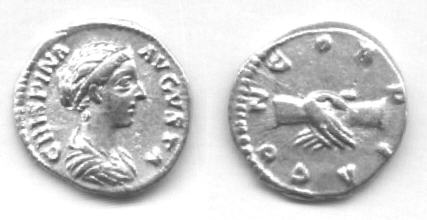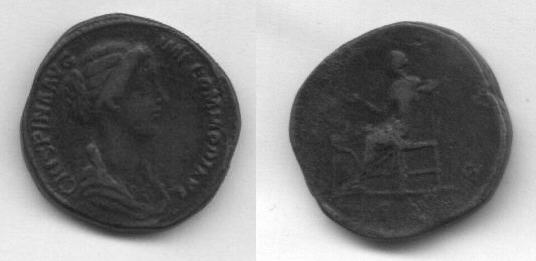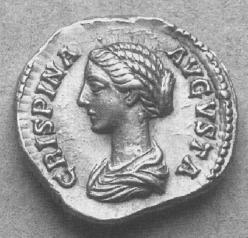
Silver Denarius, struck 180 AD
Obverse: Inscription: CRISPINA AVGVSTA; Draped bust of Crispina facing right, her hair wound tightly in plaits and knotted into a chignon at the back.
Reverse: Inscription: CONCORDIA; Clasped hands.
This piece was struck to commemorate the union between Commodus, son of the emperor Marcus Aurelius and heir to the throne, and Crispina. The reverse of this coin is rather ironic because it proclaims the concord ("CONCORDIA") and happiness of the recent marriage when in fact Commodus greatly disliked his new wife.

Bronze Sestertius, struck 180-182 AD
Obverse: Inscription: CRISPINA AVG IMP COMMODI AVG; Draped bust of Crispina facing right, her hair wound tightly in plaits and knotted into a chignon at the back.
Reverse: Inscription: SALUS, SC in exergue; Salus, goddess of health and healing, seated facing left, holding patera from which she feeds a serpent arising from an altar.


Gold Aureus of Crispina
Zurich, Bank Leu Ltd., Auction 52 (May 1991)
Born in 164, Buttia Crispina was the daughter of L. Fulvius Buttius Praesens, who accompanied the emperor Marcus Aurelius on his expidition against the Sarmations. After the subsequent triumph in 177AD, Marcus' son Commodus became co-emperor with his father and married Crispina. Commodus' personality changed drastically soon after he became sole emperor in 180, probably as a result of madness. This lead to a failed senatorial conspiracy against him in 182, afterwhich the head conspirators, among them his sister Lucilla and her husband, were executed. It is likely that Crispina was implicated in some way because soon after she was banished by Commodus to Capri on a charge of adultery and there executed in 183.
